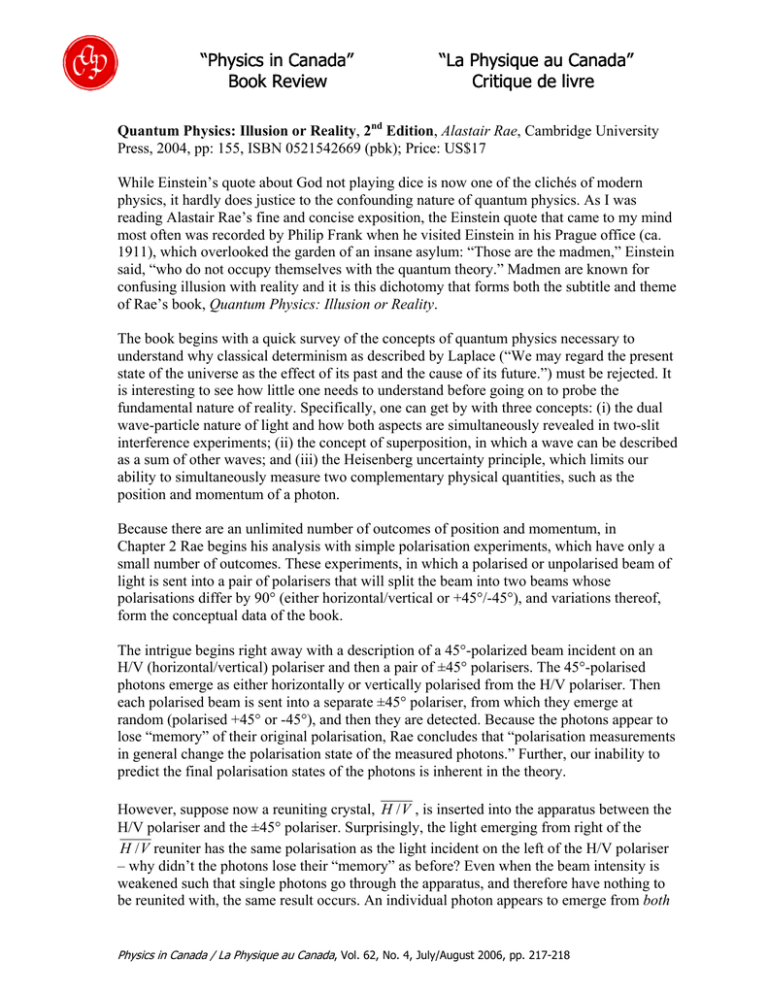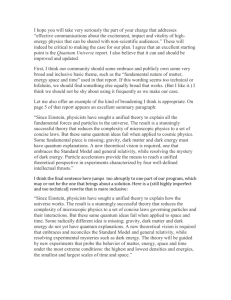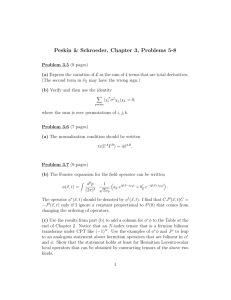“Physics in Canada” “La Physique au Canada”
advertisement

“Physics in Canada” Book Review “La Physique au Canada” Critique de livre Quantum Physics: Illusion or Reality, 2nd Edition, Alastair Rae, Cambridge University Press, 2004, pp: 155, ISBN 0521542669 (pbk); Price: US$17 While Einstein’s quote about God not playing dice is now one of the clichés of modern physics, it hardly does justice to the confounding nature of quantum physics. As I was reading Alastair Rae’s fine and concise exposition, the Einstein quote that came to my mind most often was recorded by Philip Frank when he visited Einstein in his Prague office (ca. 1911), which overlooked the garden of an insane asylum: “Those are the madmen,” Einstein said, “who do not occupy themselves with the quantum theory.” Madmen are known for confusing illusion with reality and it is this dichotomy that forms both the subtitle and theme of Rae’s book, Quantum Physics: Illusion or Reality. The book begins with a quick survey of the concepts of quantum physics necessary to understand why classical determinism as described by Laplace (“We may regard the present state of the universe as the effect of its past and the cause of its future.”) must be rejected. It is interesting to see how little one needs to understand before going on to probe the fundamental nature of reality. Specifically, one can get by with three concepts: (i) the dual wave-particle nature of light and how both aspects are simultaneously revealed in two-slit interference experiments; (ii) the concept of superposition, in which a wave can be described as a sum of other waves; and (iii) the Heisenberg uncertainty principle, which limits our ability to simultaneously measure two complementary physical quantities, such as the position and momentum of a photon. Because there are an unlimited number of outcomes of position and momentum, in Chapter 2 Rae begins his analysis with simple polarisation experiments, which have only a small number of outcomes. These experiments, in which a polarised or unpolarised beam of light is sent into a pair of polarisers that will split the beam into two beams whose polarisations differ by 90° (either horizontal/vertical or +45°/-45°), and variations thereof, form the conceptual data of the book. The intrigue begins right away with a description of a 45°-polarized beam incident on an H/V (horizontal/vertical) polariser and then a pair of ±45° polarisers. The 45°-polarised photons emerge as either horizontally or vertically polarised from the H/V polariser. Then each polarised beam is sent into a separate ±45° polariser, from which they emerge at random (polarised +45° or -45°), and then they are detected. Because the photons appear to lose “memory” of their original polarisation, Rae concludes that “polarisation measurements in general change the polarisation state of the measured photons.” Further, our inability to predict the final polarisation states of the photons is inherent in the theory. However, suppose now a reuniting crystal, H / V , is inserted into the apparatus between the H/V polariser and the ±45° polariser. Surprisingly, the light emerging from right of the H / V reuniter has the same polarisation as the light incident on the left of the H/V polariser – why didn’t the photons lose their “memory” as before? Even when the beam intensity is weakened such that single photons go through the apparatus, and therefore have nothing to be reunited with, the same result occurs. An individual photon appears to emerge from both Physics in Canada / La Physique au Canada, Vol. 62, No. 4, July/August 2006, pp. 217-218 channels of the H/V polariser. Or, if it passes along only one channel, do the photons somehow “know” what they are going to do had they passed through the other? From these simple experiments, Rae summarizes the two different ways of looking at quantum phenomena: “Either the physical world is essentially indeterministic – the photons don’t know what they are going to do… [or] they do know, but conspire to keep this information hidden from us.” Given Einstein’s abhorrence to a dice-playing God, one can now see his attraction to this latter interpretation, the so-called hidden variable theories. It turns out that indeterminism wasn’t the greatest of Einstein’s concerns. Rather, as Rae describes in Chapter 3, he realized that “quantum physics implies there is a non-local interaction between separated particles, i.e. they appear to influence each other when far apart.” This, effectively, was beyond Einstein’s concept of reality and why, together in a paper with Podolsky and Rosen (the famous EPR paper), he described quantum mechanics as incomplete. Unfortunately for him, Bell’s theorem (given a neat, minimally mathematical proof here) shows that there is non-local interaction – hidden variable theories cannot preserve locality. For his part in the debate, Bohr responded by assuming the veracity of quantum mechanics and accepting the instantaneous correlations between the well-separated particles. In the Copenhagen interpretation, described in Chapter 4, a quantity can only be considered real “if it has been measured or if it is in a measurement situation where the outcome is predictable.” Bohr subsequently anticipates difficulties by saying they “arise only when we try to extrapolate beyond the actual measured reality and to attribute ‘reality’ to the photons before they interact with the apparatus” – both of which are forbidden by the Copenhagen interpretation. What comes through here and elsewhere in the book is the notion of to what degree “reality” can truly be probed. The rest of the chapter, and the rest of the book, is devoted to the measurement problem – when can we say the wave function has collapsed into an either/or state (rather than a superposition)? Rae examines it from the point of view of consciousness (Chapter 5), the many worlds interpretation (Chapter 6), spontaneous collapse due to interaction with a macroscopic object (Chapter 7), whether Ilya Prigogine’s work on irreversible processes offer a way out (Chapters 8 and 9), a new chapter on consistent histories (Chapter 10), which allow the calculation of probabilities of events even if no measurement is made. In the final chapter, Rae refreshingly gives his own opinions on the various interpretations. This book is a crash course on the fundamentals of quantum mechanics. It is clearly written and features numerous recapitulations to aid the reader. Figures are simple with good, explanatory captions. While reading the book, I often had the feeling that this is an exciting time for quantum mechanics research and philosophy, with much more excitement (and possibly confusion) to come in the years ahead. It is highly recommended. Daniel Hudon Boston University Boston, Massachusetts, USA Physics in Canada / La Physique au Canada, Vol. 62, No. 4, July/August 2006, pp. 217-218 2







